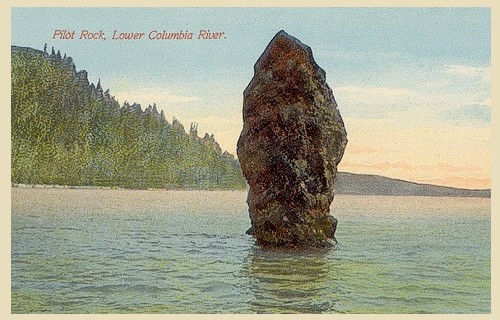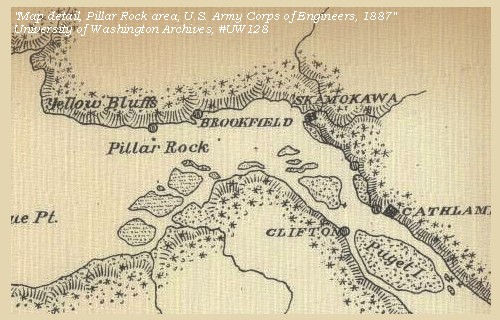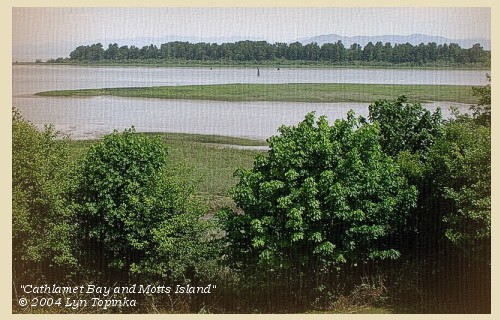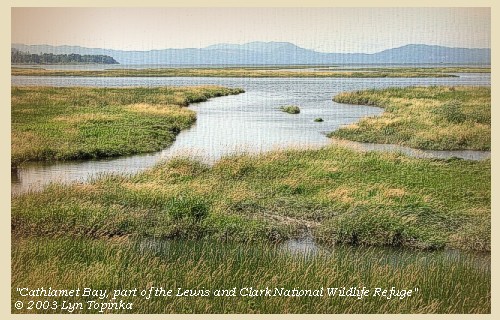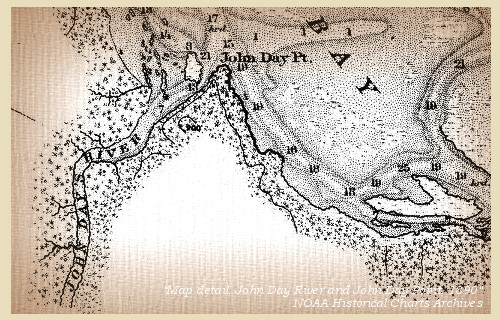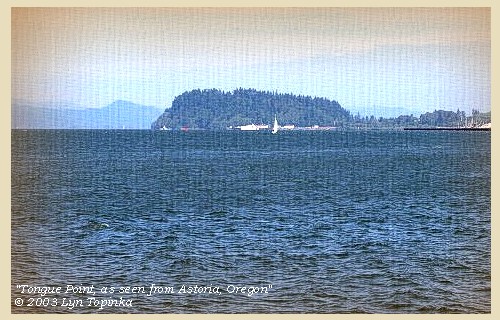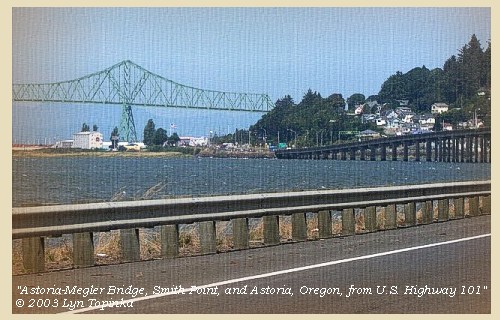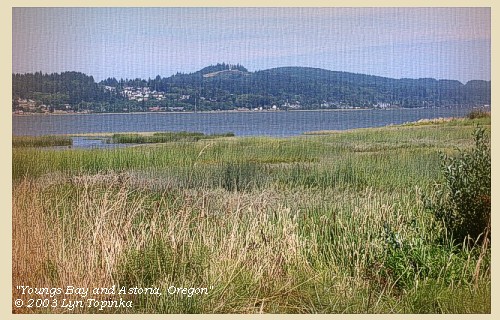The Volcanoes of
Lewis and Clark
Lewis and Clark
|
November 26 - 30, 1805 Looking for a Place to Winter - Pillar Rock to Tongue Point |
|
Home
The Volcanoes of Lewis and Clark Map of the Journey Volcanoes, Basalt Plateaus, Major Rivers, etc. The Volcanoes Mount Adams, Mount Hood, Mount Jefferson, Mount Rainier, and Mount St. Helens CALENDAR of the Journey October 1805 to June 1806 Along the Journey Pacific Northwest Maps - Columbia River, Volcanoes, Flood Basalts, Missoula Floods, Geology, etc. The Corps of Discovery The Journey of Lewis and Clark About the Reference Materials The Journals, Biddle/Allen, DeVoto, Gass, Moulton, Topo Maps, and others USGS Lewis and Clark Links Links to USGS Websites highlighting the Lewis and Clark Journey Resources Publications Referenced and Websites Visited |
PREVIOUS
November 25 Looking for a Place to Winter, Station Camp to Pillar Rock |
November 26-30
Looking for a Place to Winter Pillar Rock to Tongue Point Pillar Rock, Cathlamet Point - Aldrich Point, Cathlamet Bay and the Lewis and Clark NWR, Cathlamet Bay, Settler Point, and the Twilight Eagle Sanctuary, John Day River (Clatsop County), Tongue Point, Pebbles of Various Colors, Smith Point and Astoria, and Youngs Bay |
CONTINUE
December 1-6 Looking for a Place to Winter - At Tongue Point |
|
At the Pacific - November 1805
Looking for a Place to Winter - Pillar Rock to Tongue Point |
| Lewis and Clark's camp of November 25, 1805, was near Pillar Rock, Washington, close to their camp of November 7, 1805. |
| Tuesday, November 26, 1805 |
| in the morning. it rained. We set out with the wind from east northeast, and a short distance above the rock [Pillar Rock], near our camp, began to cross the river. |
| We passed between some low, marshy islands, which we called the Seal islands [today this area is the Lewis and Clark National Wildlife Refuge, see Cathlamet Bay entry below], and reached the south side of the Columbia at a bottom three miles below a point, to which we gave the name of point Samuel [Cathlamet Point - Aldrich Point]. |
| "... Cloudy and Some rain this morning from 6 oClock. wind from the E. N. E, we Set out out early and crossed a Short distance above the rock out in the river, & between Some low marshey Islands to the South Side of the Columbia at a low bottom about 3 miles below Point 'Samuel' and proceeded near the South Side leaveing the Seal Islands to our right and a marshey bottom to the left ..." [Clark, November 26, 1805] |
| After going along the shore for five miles, we entered a channel two hundred yards in width, which separates from the main land a large, but low island [one of the marshy islands in the Lewis and Clark National Wildlife Refuge]. On this channel, and at the foot of some highlands, is a village, where we landed [near today's town of Knappa, Oregon]. It consists of nine large wooden houses, inhabited by a tribe called Cathlamahs, who seem to differ neither in dress, language, nor manners, from the Chinnooks and Wahkiacums: like whom they live chiefly on fish and wappatoo roots. We found, however, as we hoped, some elk meat: after dining on some fresh fish and roots, which we purchased from them at an immoderate price, we coasted along a deep bend of the river towards the south [Lewis and Clark are entering Cathlamet Bay, today part of the Lewis and Clark National Wildlife Refuge.], |
| and at night encamped under a high hill [along the South Channel of Cathlamet Bay, downstream of Settler Point, in area of today's Twilight Eagle Sanctuary]; all the way from the village the land is high, and has a thick growth of pine balsam, and other timber; but as it was still raining very hard, it was with difficulty we procured wood enough to make fires. Soon after we landed, three Indians from the Cathlawah village came down with wappatoo roots, some of which we purchased with fish-hooks. |
|
|
|
The Camp - November 26, 1805
Lewis and Clark's camp of November 26, 1805, was on the southern bank of the South Channel of Cathlamet Bay (Oregon side), downstream of Settlers Point and upstream of a small creek. Perhaps the area of today's Eskaline Creek. Today this is the location of the Twilight Eagle Sanctuary. |
| Wednesday, November 27, 1805 |
| At daylight the next morning ... We went on in the rain, which had continued through the night, and passing between a number of islands [following the shoreline of Cathlamet Bay] came to a small river, called by the Indians Kekemahke [John Day River, Clatsop County]. |
| We afterwards came to a very remarkable knob of land [Tongue Point], projecting about a mile and a half towards Shallow bay [Grays Bay, on the Washington side of the Columbia], and about four miles round, while the neck of land which connects it to the main shore is not more than fifty yards wide. We went round this projection, which we named point William [Tongue Point]; |
| but the waves then became so high that we could not venture any farther, and we therefore landed on a beautiful shore of pebbles of various colours, |
|
|
|
Pebbles of Various Colors:
The colored pebbles were probably derived from the Pliocene-age Troutdale Formation which contains rounded quartz and chert gravels derived from sources upstream in the Columbia Plateaus and deposted in this area by the Columbia River. -- Moulton, 1990, v.6 |
| and encamped near an old Indian hut on the isthmus. [west side of the neck of Tongue Point] In drawing our canoes in shore, we had the misfortune to make a split two feet long in one of them. This isthmus opposed a formidable barrier to the sea, for we now found that the water below is salt, while that above is fresh and well tasted. It rained hard during the whole day; it continued all night, and in the morning, |
|
|
|
The Camp - November 27 through December 6, 1805
On the west side of Tongue Point, just east of present-day Astoria, Oregon. The majority of the party under Captain Clark remained here until December 7, 1805, while Captain Lewis and five men scouted for a suitable winter camp. |
| Thursday, November 28, 1805 |
| began more violently, attended with a high wind from the southwest. It was now impossible to proceed on so rough a sea. We therefore sent several men to hunt, and the rest of us remained during the day, in a situation the most cheerless and uncomfortable. On this little neck of land [the men are on the west side of Tongue Point] we are exposed with a miserable covering, which does not deserve the name of a shelter to the violence of the winds; all our bedding and stores, as well as our bodies are completely wet, our clothes rotting with constant exposure, and no food except the dried fish brought from the falls, to which we are again reduced. The hunters all returned hungry, and drenched with rain, having seen neither deer nor elk, and the swan and brant too shy to be approached. At noon the wind shifted to the northwest, and blew with such tremendous fury that many trees were blown down near us. This gale lasted with short intervals during the whole night; but towards morning, |
|
|
|
The Camp - November 27 through December 6, 1805
On the west side of Tongue Point, just east of present-day Astoria, Oregon. The majority of the party under Captain Clark remained here until December 7, 1805, while Captain Lewis and five men scouted for a suitable winter camp. |
| Friday, November 29, 1805 |
| the wind lulled, though the rain continued, and the waves were still high. Captain Lewis took the Indian canoe, which is better calculated for rough weather, and with five men went down to a small bay below us [Youngs Bay], where we expect to find elk. |
| "... the wind being so high the party were unable to proceed with the perogues. I determined therefore to proceed down the river on it's E. side in surch of an eligible place for our winters residence and accordingly set out early this morning in the small canoe accompanyed by 5 men. drewyer R. Fields, Shannon, Colter & labiesh. proceeded along the coast. ... 5 m. to a point of land passing two points one at 3 m. bearing S 10 W. and the 2ed at 1 1/2 further a little retreating from the 1st land high and woods thick. 2 ml. along the point, land still high and thickly timbered here a deep bay commences runing 2 m. along the bay. the land more open, pass a small prarie at 1 M. ..." [Lewis, November 28, 1805] |
| Captain Lewis and his men entered passed by Smith Point (Astoria, Oregon) and entered Youngs Bay. |
| Three other men set out at the same time to hunt in different directions, and the rest remained round the smoke of our fires drying leather, in order to make some new clothes. The night brought only a continuation of rain and hail, with short intervals of fair weather, till in the morning, |
|
|
|
The Camp - November 27 through December 6, 1805
On the west side of Tongue Point, just east of present-day Astoria, Oregon. The majority of the party under Captain Clark remained here until December 7, 1805, while Captain Lewis and five men scouted for a suitable winter camp. |
| Saturday, November 30, 1805 |
| it cleared up about nine o'clock, and the sun shone for several hours. Other hunters were now sent out, and we passed the remainder of the day in drying our merchandise so long exposed. ...... The hills along the coast are high and steep, and the general covering is a growth of lofty pines of different species, some of which rise more than two hundred feet, and are ten or twelve feet in diameter near the root. Besides these trees we observe on the point a species of ash, the alder, the laurel, one species of the wild crab, and several kinds of underbrush, among which the rosebushes are conspicuous. |
|
|
|
The Camp - November 27 through December 6, 1805
On the west side of Tongue Point, just east of present-day Astoria, Oregon. The majority of the party under Captain Clark remained here until December 7, 1805, while Captain Lewis and five men scouted for a suitable winter camp. |
| Home | Previous | Continue |
If you have questions or comments please contact: GS-CVO-WEB@usgs.gov
June/July 2004, Lyn Topinka
The Volcanoes of Lewis and Clark Home Page | CVO Home Page


